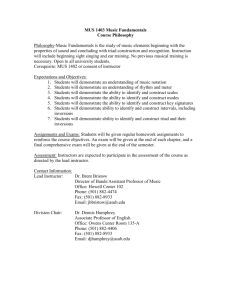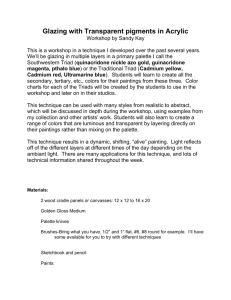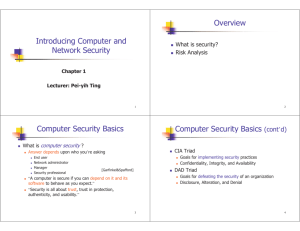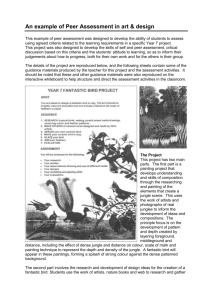Triads - Dave Drapeau Home
advertisement
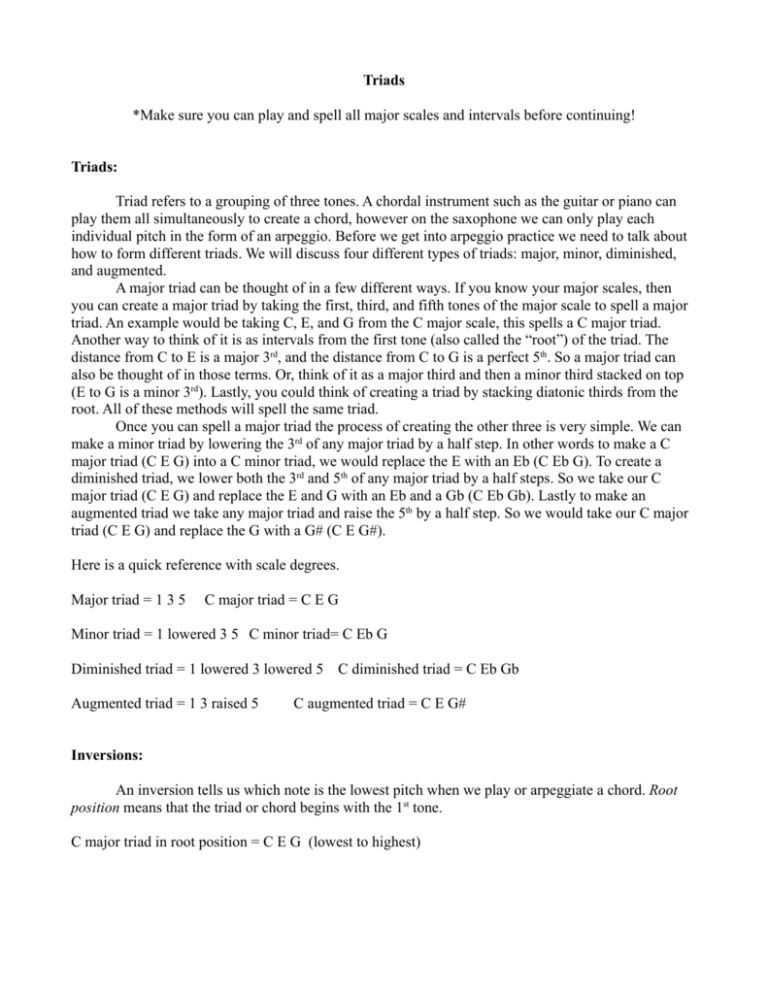
Triads *Make sure you can play and spell all major scales and intervals before continuing! Triads: Triad refers to a grouping of three tones. A chordal instrument such as the guitar or piano can play them all simultaneously to create a chord, however on the saxophone we can only play each individual pitch in the form of an arpeggio. Before we get into arpeggio practice we need to talk about how to form different triads. We will discuss four different types of triads: major, minor, diminished, and augmented. A major triad can be thought of in a few different ways. If you know your major scales, then you can create a major triad by taking the first, third, and fifth tones of the major scale to spell a major triad. An example would be taking C, E, and G from the C major scale, this spells a C major triad. Another way to think of it is as intervals from the first tone (also called the “root”) of the triad. The distance from C to E is a major 3rd, and the distance from C to G is a perfect 5th. So a major triad can also be thought of in those terms. Or, think of it as a major third and then a minor third stacked on top (E to G is a minor 3rd). Lastly, you could think of creating a triad by stacking diatonic thirds from the root. All of these methods will spell the same triad. Once you can spell a major triad the process of creating the other three is very simple. We can make a minor triad by lowering the 3rd of any major triad by a half step. In other words to make a C major triad (C E G) into a C minor triad, we would replace the E with an Eb (C Eb G). To create a diminished triad, we lower both the 3rd and 5th of any major triad by a half steps. So we take our C major triad (C E G) and replace the E and G with an Eb and a Gb (C Eb Gb). Lastly to make an augmented triad we take any major triad and raise the 5th by a half step. So we would take our C major triad (C E G) and replace the G with a G# (C E G#). Here is a quick reference with scale degrees. Major triad = 1 3 5 C major triad = C E G Minor triad = 1 lowered 3 5 C minor triad= C Eb G Diminished triad = 1 lowered 3 lowered 5 C diminished triad = C Eb Gb Augmented triad = 1 3 raised 5 C augmented triad = C E G# Inversions: An inversion tells us which note is the lowest pitch when we play or arpeggiate a chord. Root position means that the triad or chord begins with the 1st tone. C major triad in root position = C E G (lowest to highest) First inversion means that the lowest pitch is the 3rd of the chord, the root gets placed on top above the 5th. C major triad in first inversion = E G C (lowest to highest) Second inversion means that the lowest pitch is the 5th of the chord, the third gets placed on top above the root. C major triad in second inversion = G C E (lowest to highest) This may seem confusing reading through it, however once you go to the following pages and see it displayed on the staff it will probably make more sense if you are getting lost. You should practice spelling all four forms of triads for all keys, then practice them in various patterns with various articulations on your instrument. Some examples have been provided. Make sure to practice examples using all triad forms, then write some of your own to practice. Triads & 44 œ C major Scale 1 3 œ œ 3 2 4 œ 5 & ww w 4 C minor triad 1 3 5 of major scale www c augmented triad b www b b www # www raised 5th lowered 3rd and 5th lowered 3rd ∑ & ww 53 w1 root 9 C major triad in root position 12 œ 5 (8) 3 7 6 1 1 Major triads are formed from the 1st, 3rd, and 5th, of the major scale C diminished triad & & œ œ ∑ & C major triad 8 œ C major triad ww 1 root w 53 C major triad in first inversion ∑ ww w c major triad in second inversion 3 1 root 5 Triads 2 Arpeggios to practice in all keys and all four triad forms C major triad &œ 13 ˙ œ œ & 16 &œ 17 œ œ second inversion œ œ œ œ ∑ œ Full range arpeggio form œ œ œ œ œ Practice in all keys with all four triad forms and in all inversions Vary your tempo, rhythms, and articulation ∑ & ˙ œ œ first inversion root position C major ˙ œ œ Here are a Few different shapes Remember to practice each shape in every key with all four triad forms Vary your tempo, articulation, and rhythms 19 œ œ œ œ œ œ œ œ œ œ &œ œ œ œ œ œ œ œ 20 c major ascending Œ œ œ œ œ œ œ œ œ œ œ œ & œ œ œ œ œ œ œ Œ 23 c major descending C major example a &œ 26 & 28 œ œ œ œ C major example b œ œ œ œ œ œ œ œ œ œ œ œ œ œ Go write some of your own ideas! œ œ œ ˙ œ œ œ ˙ Ó Ó



